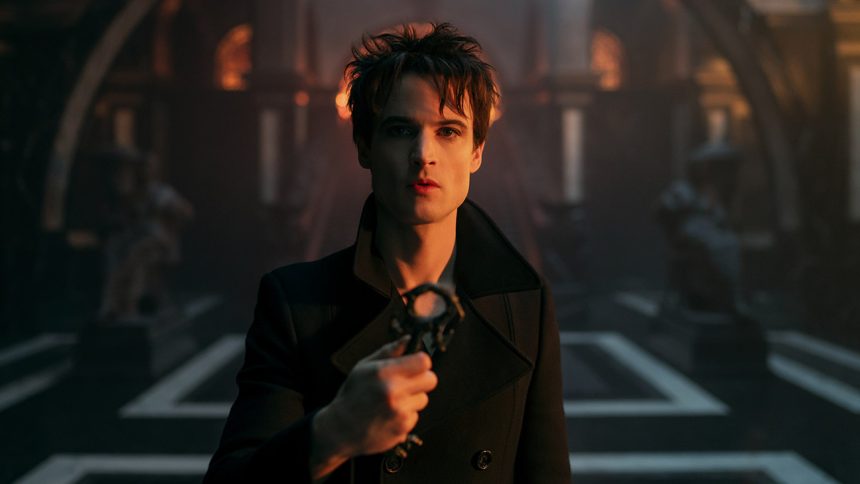‘The Sandman’ Star Ruairi O’Connor Breaks Down That Fatal Choice
[This story contains major spoilers from Part 1 of season two of The Sandman, including episode five, “The Song of Orpheus,” and six, “Family Blood.”]
In the world of The Sandman, the Endless are strictly prohibited from spilling family blood. But in the first volume of the hit Netflix fantasy drama’s second and final season, protagonist Dream a.k.a. Morpheus (Tom Sturridge) decides to break that sacred vow out of love for his estranged son Orpheus (Ruairi O’Connor), even if doing so could force the former to pay the ultimate price.
Adapted from DC Comics’ seventh collection in the Sandman series, Brief Lives, along with single-issue stories such as The Song of Orpheus and Thermidor,the fifth and sixth episodes of Part 1 shed light on the heartbreaking yet heartwarming relationship between Dream and Orpheus, whose mother was the Greek muse Calliope (Melissanthi Mahut).
In 1700 BC, the Endless siblings gathered in Greece to watch Orpheus marry Eurydice (Ella Rumpf) — only for Eurydice to die of a viper bite on the night of their wedding. Consumed by his own grief, Orpheus went against his father’s wishes and made a deal with his aunt, Death (Kirby Howell-Baptiste). In exchange for an opportunity to journey to the Underworld to plead for Eurydice’s return, Orpheus naively agreed to become immortal, telling everyone he encountered that he would give anything to spend “a lifetime or an hour more” with the love of his life. Orpheus is even able to charm Hades and Persephone with a love song in the Underworld, but Orpheus’ failure to meet their one condition for Eurydice’s release — he wasn’t allowed to look back at her until they were both back in the living world — meant that the two lovers would be separated forever.
You Might Also Like
With nothing left to live for, Orpheus put himself in the path of the Sisters of the Frenzy, a vicious cult of Dionysus, who attacked and dismembered him, reducing him to only a severed head. Desperately wanting to be put out of his misery, Orpheus begged his father to kill him, but Dream could not bring himself to administer the coup de grâce. Instead, Dream left Orpheus’ head in the indefinite care of priests on an uncharted island off the coast of Greece and told his son they could never see each other again.
“Orpheus was idealistic, and he hoped he could go down to the Underworld and rescue Eurydice and everything would be OK — and certainly not that he’d be separated from Eurydice,” O’Connor, who was already “really familiar with Greek mythology in general” prior to auditioning for The Sandman, tells The Hollywood Reporter. “If he died in a normal time, he would’ve gone to the Underworld and he would’ve possibly been with Eurydice down there. But now, it’s almost guaranteed he’s one of the only people who will never see Eurydice, and he won’t be able to move his body because it’s gone. His father had warned him that this would happen.”
As a superfan of the original Sandman comics for decades, showrunner Allan Heinberg had always wanted to adapt Dream’s relationship with Orpheus, whose arrival was teased during the press run for season one. “With Orpheus, Dream is warmer and more unguarded than he is even with Calliope,” Heinberg tells THR, remarking that Dream’s discouragement of Orpheus’ plan to sacrifice his life for Eurydice’s was what any protective parent would have done in Dream’s position. (Read THR’s full interview with Heinberg about volume one here.)
After Orpheus was decapitated in the comics, Heinberg says, Dream always seemed like “an Old Testament God” who was punishing his rebellious son for disobeying an order. But in his two-season adaptation of creator Neil Gaiman’s comics, Heinberg has been more interested in exploring the emotional cost of the King of Dreams’ job on his relationships as a brother, lover and father. In keeping with that theme, although the dialogue onscreen is nearly identical to that of the comics, the showrunner wanted to show Dream’s heartbreak over not being able to help save his son.
“The reason [Dream] says, ‘We will not see each other again,’ is that Dream can’t handle [seeing him like that],” says Heinberg. “From that point of view, as Dream’s walking away from Orpheus, we can see that he is absolutely shattered instead of stone-faced and punishing. You understand how hard this is for him.”
Through his extensive discussions with Heinberg, O’Connor came to understand that Orpheus’ initial, childlike animosity toward Dream stemmed from feeling abandoned by his father, who had chosen to prioritize his responsibilities to humanity over his own family. “It reminded me a bit of, like, if Abraham Lincoln was your father — he belongs to you a little bit because he’s your father, but he belongs to everybody else as well. I think that can be quite hard on a child,” explains O’Connor. “It’s such a surprise for [Dream] to be at [Orpheus’] wedding that it’s a little bit overwhelming — and almost foreboding that he is there as well.”
Heinberg adds, “The way that Dream and Orpheus speak to each other at the end of episode six is very different from the way they speak to each other in episode five. You’ve got hundreds of years of regret and recrimination in episode five. They’re very much father and son — ‘I tell you what to do and how to behave, and you do it because I am your father, and I know more than you.’ By the end of it, there are just two people who love each other enormously.”
O’Connor could feel the weight of that father-son relationship when acting opposite Sturridge, whom he first saw perform opposite Jake Gyllenhaal in the Broadway production of Sea Wall/A Life in 2019. Even though Sturridge is only five or six years older, “it felt like I was coming to play with someone who was a good few steps above me. I had the reverence to feel like, ‘This man’s a thousand years older than me in certain regards,’” O’Connor says. “I think that energy — that struggle — of really trying to live up to him and not being able to do it, but honestly trying to do it, helped [those scenes].”
He adds of Sturridge, “He also looks amazing. You look at his face and you’re like, ‘Why can’t my face look like that?’ I really respect him and am envious of him in many ways, and I hope that gels with what we were trying to do.”
O’Connor, on more than one occasion, tells THR that he thinks the gods were smiling down on him during his time on The Sandman. Last year, after multiple rounds of self-tape auditions, the Irish actor — best known for his work in The Spanish Princess and The Conjuring: The Devil Made Me Do It — landed the role just weeks before he was scheduled to begin filming. He began obsessively poring over all the comics involving Orpheus. He even learned how to play the lyre, even though he never had to play his character’s instrument of choice on camera.
But the most challenging aspect of the role was learning how to sing in Greek. “It was just impossible, so I ended up chanting and listening to it. It became hypnotic, almost like mantras in my head,” O’Connor recalls. “I felt like I was going crazy just trying to get the Greek into me, and then knowing on the day that I was going to have to sing it and that it’s going to have to certainly match my mouth movements and everything as much as possible.”
In addition to singing live on the day, the actor recorded the final version of Orpheus’ songs at Abbey Road Studios. “I’m not religious, so music is probably the closest thing. My voice was a bit rough that day, so [the producers] were like, ‘Come down to studio two where the Beatles recorded, and we’ll warm up your voice,” O’Connor recalls, sheepishly revealing that he ended up bringing his best friend that day and the two sang “Hey Jude” on the piano as a warm-up. “I don’t know — it made me feel like music does have the power that Orpheus imbues in it, that it changes lives.”
To play Orpheus after his body has been ripped apart, O’Connor had to get a cast made of his own head. “The amazing thing with the casts is they have all the other heads they’ve done over the years. I had Brad Pitt’s head in my hands, and I was looking at the shape of his head to see why he’s so handsome,” O’Connor quips. “It is a surprisingly small head! I was like, ‘Maybe that’s the key.’
“They had three heads that they made up, and one of them was impeccably me and the others were for more wide shots, and I was like, ‘Is that what people think I look like? Hopefully not!’ But the main one was definitely a better version of me,” he continues. “It was great because my costume before [the decapitation] had all of these spindly bits. I was wearing four wedding dresses basically on the side of a mountain, often tripping up over it. And now, I was just wearing a green bodysuit, but, of course, I was locked in with a thing around my neck so I wouldn’t move.”
While some actors in his position may have been daunted, O’Connor found the experience of acting with just his head to be “strangely liberating.” The crew found creative ways to maintain the illusion of a literal talking head — holes were cut into tables at perfect angles, his co-stars had to pretend to lift his head while he stood up slowly — which was then improved in post-production.
“My hands didn’t have to be onscreen at all, so I could do whatever I wanted because they would take it out. It took away a lot of the avenues for mistakes you could make or for going over the top,” O’Connor says, adding that he’d “actually love to do another role” like that. “If Return to Oz 2 ever happens or something where they need a king that changes his heads, maybe I could get that to be my niche,” he jokes.
Episode six began with Dream contacting Lady Johanna Constantine (Jenna Coleman) in the late 18th century with an urgent request: He needed her to go to Paris and retrieve Orpheus’ head, which Maximilien Robespierre had confiscated during his Reign of Terror and was planning to destroy for being “an object of superstition and decadence.” Upon being found out, Johanna was thrown in prison and even faced the threat of being executed by guillotine, but she had cleverly chosen to hide Orpheus in a pile of heads belonging to Robespierre’s other victims. At Dream’s suggestion, Johanna asked Orpheus to sing in front of Robespierre and his men, who were then left frozen in their tracks, allowing Johanna to flee with Orpheus’ noggin.
As they began the journey back to Orpheus’ temple, Johanna and Orpheus took a special liking to each other as friends. In fact, Johanna’s sole request for successfully completing her mission was to spend more time with Orpheus — a wish that Dream clearly granted, since she was buried near the temple after her death.
Speaking about what Johanna saw in Orpheus, O’Connor points out that his character seemed to have “found a peace, a maturity and an acceptance to living and existing possibly forever with no means to do anything for himself.”
“I think Johanna comments that there’s something inspiring about what he’s been able to do,” O’Connor says. “I watched that [documentary] recently with Christopher Reeve, and of course he had his horse accident and you can see it’s awful, but there’s a liberation as well in knowing he could overcome that for so long. Orpheus has been doing something akin to that for thousands of years, and he can appreciate Johanna because she’s the opposite. She’s alive and vivacious, and moving and tricking people. I think they appreciate the opposite in each other.”
Heinberg adds, “Orpheus, at that point, is so philosophical about his fate and trying to spend his days as best he can. Even though he longs for the peace of death, he’s not an unhappy man. He’s not suffering, and Dream is suffering and has been suffering since he left him on the beach.”
In the present day, Dream has no choice but to visit Orpheus, because he is the only living person who can locate Dream’s brother, Destruction (Barry Sloane), who abandoned his realm some 300 years ago. While Orpheus would have good reason to be angry or resentful with his father, he chooses instead to be “loving, accepting and forgiving,” Heinberg says. “It’s such a relief for Dream in that moment because he’s been dreading having to face the biggest mistake he’d ever made.”
In exchange for Orpheus’ help in locating Destruction, Dream agrees to grant Orpheus the one boon he has always wanted. So, after Dream and Delirium (Esmé Creed-Miles) track down Destruction to confirm that he will not helm his realm again, Dream returns to the temple and — out of love — ends his son’s life.
“I think him saying, ‘I’m ready now, father,’ was the important thing — for him to have agency,” O’Connor says of shooting Orpheus’ final moments. “He wasn’t begging him to kill him. He knows that he will do it for him, but he gets to finally make a decision and be the adult, and asks his father to do it. His father was robbed of being a father because of who he was, and in this moment, it’s clear that he’s doing something that only a father would do for his son.”
Dream solemnly bids farewell to Delirium and returns to his palace, where he instructs his librarian and property manager Lucienne (Vivienne Acheampong) to relieve the priests of their duties after they bury Orpheus’ head in an unmarked grave. He then returns to his own room and finally breaks down while washing Orpheus’ blood off his hands.
Heinberg reveals that Dream’s decision to hide behind a bookcase while delivering the orders to Lucienne was not scripted: “It was our DP Will Baldy’s idea in the moment, like, ‘What if it’s too much for him and he can’t face her? And his not showing himself to her shatters her.’ It was such a lovely collaborative idea, and it sets up that scene in his private quarters where he’s washing the blood off his hands in such a beautiful way.”
In volume two, Dream will inevitably have to answer to the Fates — a.k.a. the Furies — for spilling family blood. But, true to form, he will not take his fate lying down. “Dream is going to do everything he possibly can to keep his life and his kingdom, and the people who work with him, whole and safe and alive,” Heinberg teases. (He is specifically hinting at a line in the season premiere where Dream says he has made arrangements for the Dreaming to survive, even if he does not.) “He’s going to fight for the next five episodes, because that’s who he is. So it’s not over, and there are lots of surprises along the way.”
***
The Sandman is now streaming on Netflix. The next five episodes, which will conclude Dream’s story, will drop on July 24, with a bonus episode centered around Death dropping on July 31.Read THR’s full interview with Heinberg about Part 1.







